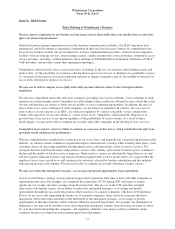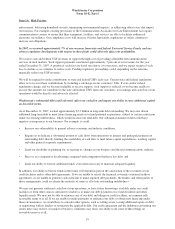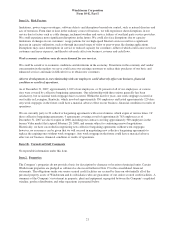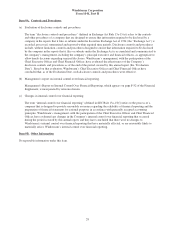Windstream 2007 Annual Report Download - page 64
Download and view the complete annual report
Please find page 64 of the 2007 Windstream annual report below. You can navigate through the pages in the report by either clicking on the pages listed below, or by using the keyword search tool below to find specific information within the annual report.
Windstream Corporation
Form 10-K, Part I
Item 1A. Risk Factors
We could be harmed by rapid changes in technology.
The communications industry is experiencing significant technological changes, particularly in the areas of VoIP, data
transmission and wireless communications. Rapid technological developments in wireless, personal communications
services, digital microwave, satellite, high-speed Internet radio services, local multipoint distribution services, meshed
wireless fidelity, or WiFi, and other wireless technologies could result in the development of products or services that
compete with or displace those offered by traditional local exchange carriers (“LECs”). For example, we may be
unable to retain existing customers who decide to replace their wireline telephone service with wireless telephone
service. In addition, the development and deployment of cable and high-speed Internet technology will result in
additional local telephone line losses for us if customers choose VoIP for their local telephone service. Additional
access line loss will also likely occur as customers shift from dial-up data services, which are often on a second phone
line, to high-speed data services. Furthermore, the proliferation of replacement technologies impacting our wireline
business could require us to make significant additional capital investment in order to compete with other service
providers that may enjoy network advantages that will enable them to provide services more efficiently or at a lower
cost. Alternatively, we may not be able to obtain timely access to new technology on satisfactory terms or incorporate
new technology into our systems in a cost effective manner, or at all. If we cannot develop new services and products
to keep pace with technological advances, or if such services and products are not widely embraced by our customers,
our results of operations could be adversely impacted.
We provide services to our customers over access lines, and if we continue to lose access lines like we have
historically, our revenues, earnings and cash flows from operations could be adversely affected.
Our business generates revenue by delivering voice and data services over access lines. We have experienced net
access line loss over the past few years. During 2007, excluding the access lines acquired from CTC, the number of
access lines we served declined by approximately 4.6 percent due to a number of factors, including increased
competition and wireless and high-speed Internet substitution. We expect to continue to experience net access line loss
in our markets. Our inability to retain access lines could adversely affect our revenues, earnings and cash flow from
operations.
We are subject to various forms of regulation from the Federal Communications Commission (“FCC”) and state
regulatory commissions in the 16 states in which we operate, which limits our pricing flexibility for regulated voice
and high-speed Internet products, subjects us to service quality, service reporting and other obligations, and exposes
us to the reduction of revenue from changes to the universal service fund or the inter-carrier compensation system.
As a provider of wireline communication services, we have operating authority from each of the 16 states in which we
conduct local service operations, and we are subject to various forms of regulation from the regulatory commissions in
each of these 16 states as well as from the FCC. State regulatory commissions have primary jurisdiction over local and
intrastate services including, to some extent, the rates that we charge customers and other telecommunications
companies, and service quality standards. The FCC has primary jurisdiction over interstate services including the rates
that we charge other telecommunications companies that use our network and other issues related to interstate service.
These regulations restrict our ability to adjust rates to reflect market conditions and affect our ability to compete and
respond to changing industry conditions.
Future revenues, costs, and capital investment in our wireline business could be adversely affected by material changes
to these regulations, including, but not limited to, changes in inter-carrier compensation, state and federal USF support,
UNE and UNE-P pricing and requirements, and VoIP regulation. Federal and state communications laws may be
amended in the future, and other laws may affect our business. In addition, certain laws and regulations applicable to us
and our competitors may be, and have been, challenged in the courts and could be changed at any time. We cannot
predict future developments or changes to the regulatory environment or the impact such developments or changes
would have.
In addition, these regulations could create significant compliance costs for us. Delays in obtaining certifications and
regulatory approvals could cause us to incur substantial legal and administrative expenses, and conditions imposed in
connection with such approvals could adversely affect the rates that we are able to charge our customers. Our business
also may be affected by legislation and regulation imposing new or greater obligations related to assisting law
18
























